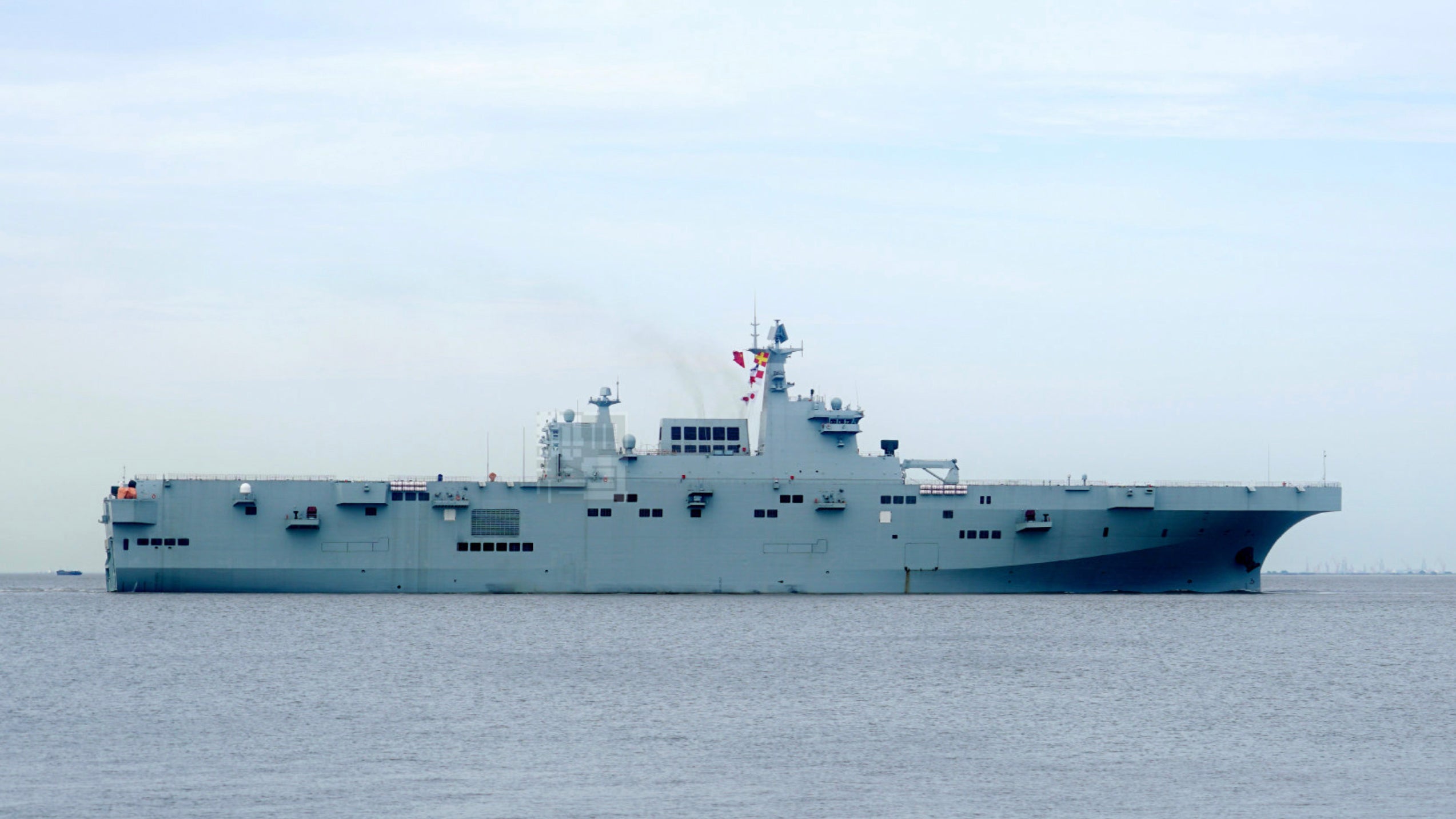The first of China’s big-deck amphibious assault ships has begun sea trials. Photos and video of the lead vessel in the People’s Liberation Army Navy’s Type 075 class emerged earlier today when the still-unnamed warship departed the pier at Hudong-Zhonghua Shipyard in Shanghai.
The ship’s first sailing follows a period of remarkably rapid construction and a serious fire that occurred in port in April. At the time, it was unclear how much damage had resulted from the blaze, which seemed to have emanated from, or at least involved, the well deck of the big-deck amphibious assault ship, also referred to as a landing helicopter dock (LHD). Whatever damage was sustained now seems to have been fixed, although smoke stains were still visible as the warship went to sea today. Furthermore, some photos purportedly showing the trials suggest the flight deck is still incomplete.
“The presumed maiden voyage will likely test the amphibious assault ship’s main systems, including propulsion, navigation and communication,” local media reported. Quoting unnamed military analysts, The Global Times added that it expected the first Type 075 to be commissioned into PLAN service within “a year or two.”
The speed with which the vessel was completed was already impressive. Development began in 2011 and images began to emerge online of the first ship’s keel under construction between April and May 2019, though it is unclear when the China State Shipbuilding Corporation (CSSC) formally began work on it. The first of the Type 075 class was then launched on Sept. 25, 2019, and left drydock within 24 hours of the launch ceremony.
The China State Shipbuilding Corporation launched a second example of the Type 075 in April, and a third has been ordered. The rapid construction of China’s first LHD makes an interesting contrast with the U.S. Navy’s second America-class amphibious assault ship USS Tripoli, which was launched three years after its keel was laid.
It’s unclear exactly how big the Chinese LHD is. While early reports suggested it would displace “more than” 30,000 tons, this has since been revised to a figure between 35,000 and 40,000 tons. Whatever the case, the Type 075 is significantly larger than both the Australian Canberra class (27,500 tons) and the South Korea Dokdo class(18,800 tons). Such a figure puts it closer to the size of the U.S. Navy’s Wasp-class amphibious assault ships.
As a platform for maritime rotary lift, the Type 075’s hangar deck is expected to accommodate between 28 and 30 helicopters. Currently, the Z-8 family and the smaller Z-9 are the primary PLAN rotorcraft, but they are likely to be joined by the derivatives of the Z-20 in the future.
Beyond manned aircraft, it seems China may also have plans to operate a vertical takeoff and landing (VTOL) unmanned aerial vehicles (UAV) from the Type 075. An apparent mockup of just such an aircraft appeared on the deck of the first Type 075 in July, alongside a model of a Z-8J helicopter, indicating some kind of warship compatibility trials.
Analysis has suggested the VTOL drone is around 30 feet long, making it slightly smaller than a Z-9 helicopter. Exactly how such a UAV may fit into PLAN amphibious warfare doctrine is unclear, but it will most likely operate in a similar manner as the U.S. Navy’s MQ-8C Fire Scout helicopter drone.
Previously, The War Zone took a look at how the Type 075 fits into the PLAN’s wider modernization and expansion, as well as across the PLA as a whole — you can read about that here. Beyond the Type 075, it is rumored that China has ambitions to field an even more capable amphibious assault ship.
Last month it was reported that a so-called Type 076 was in planning as a follow-on design of around 40,000 tons. This is allegedly a “mini aircraft carrier” with an electromagnetic aircraft launch system, implying a fixed-wing capability from the outset. While China doesn’t currently possess a short takeoff and vertical landing (STOVL) type, this is a doctrine that’s apparently now under study, but it is more likely that this catapult would support lighter drones. The new notional vessel — which has yet to been officially approved by Beijing — would also operate up to 30 helicopters plus UAVs.
In the meantime, the Type 075 looks set to radically overhaul the PLAN’s expanding amphibious capabilities. The new warships could potentially project Chinese power throughout the Asia-Pacific region, a capability that has particular relevance to the region’s disputed areas, including the South China Sea.
Whichever way you look at it, the Type 075 that has now begun sea trials is yet another impressive accomplishment for China’s rapidly growing naval force.
Contact the author: thomas@thedrive.com
